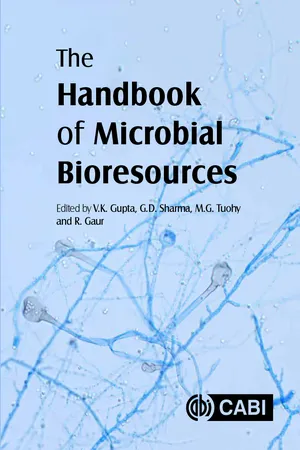Biological Sciences
Actinomycetes
Actinomycetes are a group of bacteria known for their filamentous growth and ability to produce a wide range of bioactive compounds, including antibiotics. They play a crucial role in the decomposition of organic matter in soil and are important for nutrient cycling. Actinomycetes have significant biotechnological and pharmaceutical potential due to their ability to produce diverse secondary metabolites.
Written by Perlego with AI-assistance
Related key terms
2 Key excerpts on "Actinomycetes"
- eBook - ePub
- Vijai Kumar Gupta, Gauri Dutt Sharma, Maria G Tuohy, Rajeeva Gaur(Authors)
- 2016(Publication Date)
- CAB International(Publisher)
The soil is also the most prolific source of bioactive isolates, streptomycetes being ubiquitous and most numerous and the producers of antibiotics and other useful metabolites. Actinomycetes, usually streptomycetes, are also capable of degrading many other polymers occurring in soil and litter, including hemicelluloses, pectin, keratin and chitin. Nocardiae have been implicated in the decomposition of humic materials (Goodfellow and Williams, 1983). Conventional approaches in defining the many activities of Actinomycetes documented that they were able to: (i) degrade plant, animal and microbial polymers in soil and litter; (ii) produce tastes and odour in natural portable waters; and (iii) fix nitrogen in a variety of non-leguminous plants (Goodfellow and Williams, 1983). Currently, with the utilization of novel molecular tools (e.g. metagenomics) it is now becoming possible to answer key ecological questions, including the functional roles of Actinomycetes in nature. Information will enable scientists to relate specific functions to specific microorganisms within multispecies soil communities (Cowan et al., 2005). Zhou et al. (2012) assessed the mechanisms underlying genome plasticity and systems adaptation in closely related Streptomyces strains using the sets of available genome information. When they comprehensively analysed the core genomes of five Streptomyces species with distinct phenotypes, they were found to contain important genes for Streptomyces biology. These genes were important for gene regulation, secretion, secondary metabolism and morphological differentiation. Moreover, the core genome components were essential for a sustained successful life cycle of these organisms in the soil environment. Such observations revealed the true effects of both genome evolution and environmental stress on expressed phenotypes. Cultivation-independent molecular studies including proteogenomics bring new insights into ecological understanding - eBook - ePub
Biotechnology of Microorganisms
Diversity, Improvement, and Application of Microbes for Food Processing, Healthcare, Environmental Safety, and Agriculture
- Jeyabalan Sangeetha, Devarajan Thangadurai, Somboon Tanasupawat, Pradnya Pralhad Kanekar(Authors)
- 2019(Publication Date)
- Apple Academic Press(Publisher)
CHAPTER 4SECONDARY METABOLITES AND BIOLOGICAL ACTIVITY OF Actinomycetes
KHOMSAN SUPONG1 and SOMBOON TANASUPAWAT21 Department of Applied Science and Biotechnology, Faculty of Agro-Industrial Technology, Rajamangala University of Technology, Twan-ok Chantaburi Campus, Chantaburi 22210, Thailand 2 Department of Biochemistry and Microbiology, Faculty of Pharmaceutical Sciences, Chulalongkorn University, Bangkok 10330, Thailand4.1INTRODUCTIONResearch to identify new putative antibiotics has to be pursued and intensified. Natural products, especially microbe-derived metabolites, proved themselves as a good source for antibiotics and other biologically active secondary metabolites. Besides the well-known proliferative producer organisms, like the plants and fungi, currently, in the group of bacteria, Actinomycetes have moved into focus (Bull et al., 2005). About 50,000 natural products produced by microorganisms, more than 10,000 of which are biological compounds, and more than 1000 metabolites are in use as antibiotics such as antitumor and agrochemical substances (Berdy, 2005). Recently, most of the antibiotics are produced by Actinomycetes (Berdy, 2005; Bull et al., 2005). They produce structurally diverse secondary metabolites, distinct from the classes known so far from fungal producers. Actinomycetes are known for the production of an enormous variety of biologically active secondary metabolites, including antibiotics, immunosuppressants, and anticancer agents. In addition, these metabolites such as erythromycin and streptomycin that used clinically (Figure 4.1 ). Recently, the anticancer drug, salinosporamide A has been found in the marine obligate actinomycete Salinispora tropica. In addition, abyssomicin C was isolated from marine-derived Verrucosispora
Learn about this page
Index pages curate the most relevant extracts from our library of academic textbooks. They’ve been created using an in-house natural language model (NLM), each adding context and meaning to key research topics.

